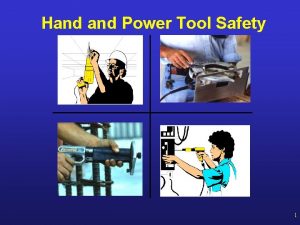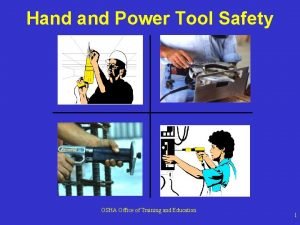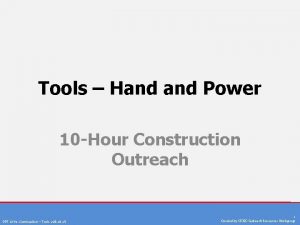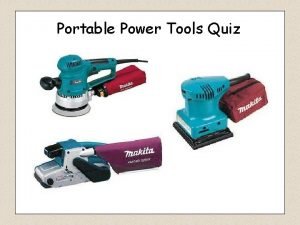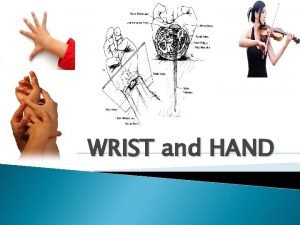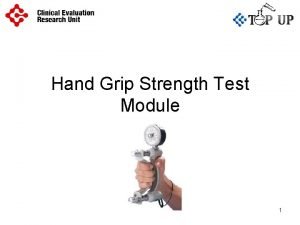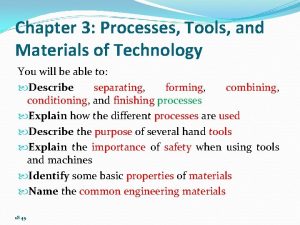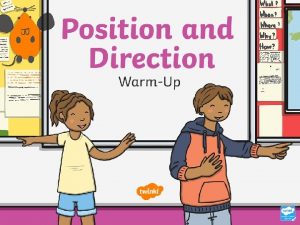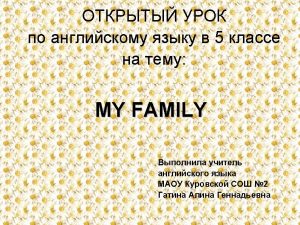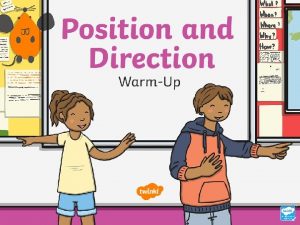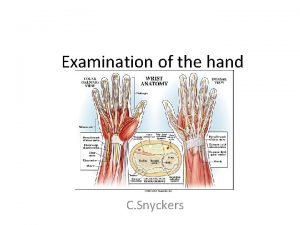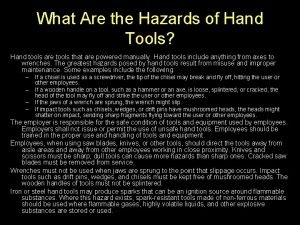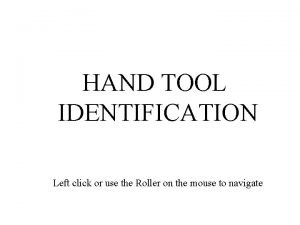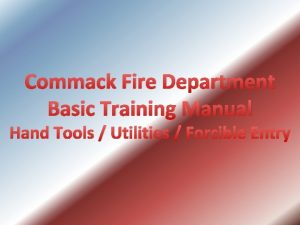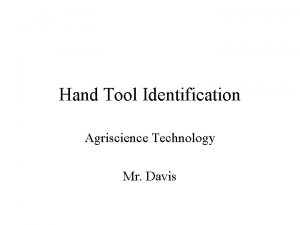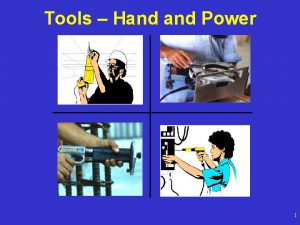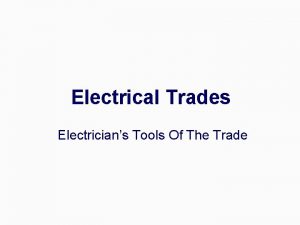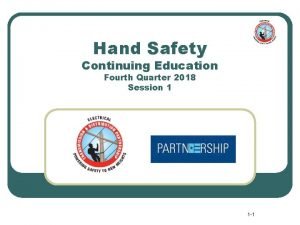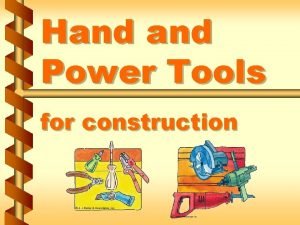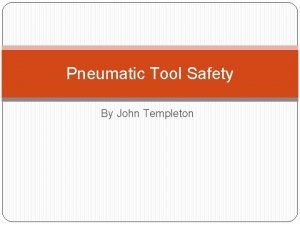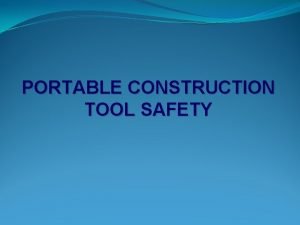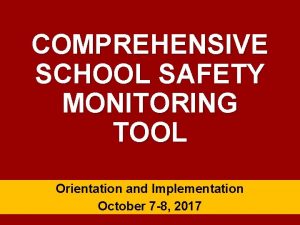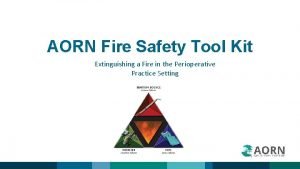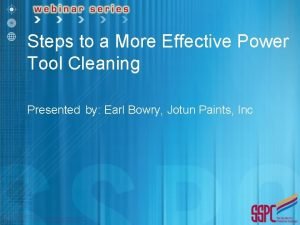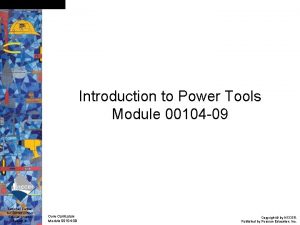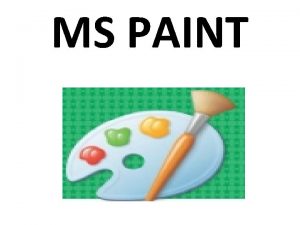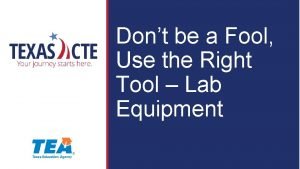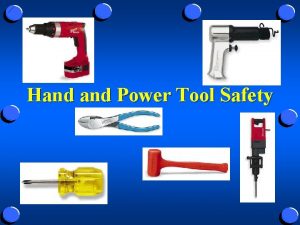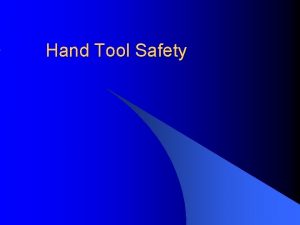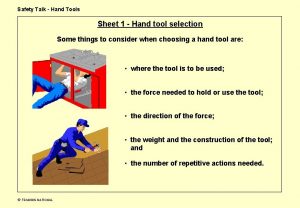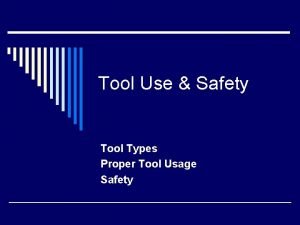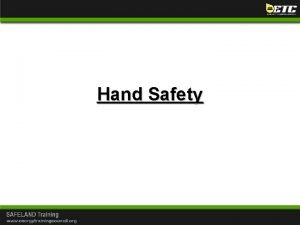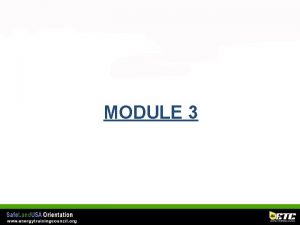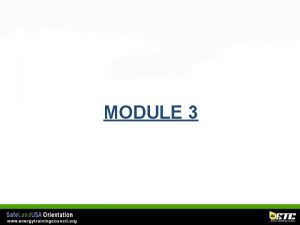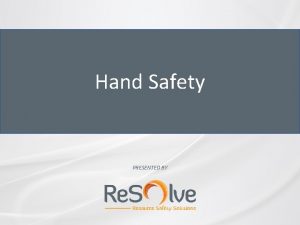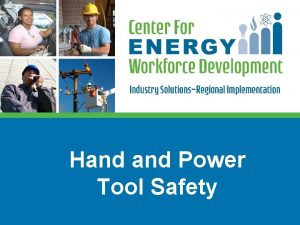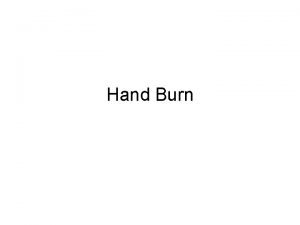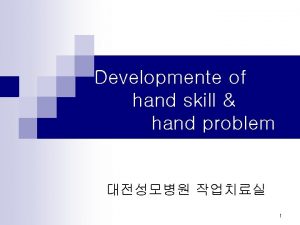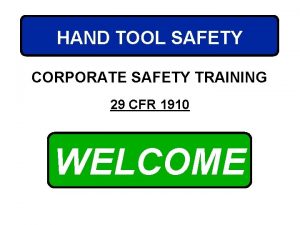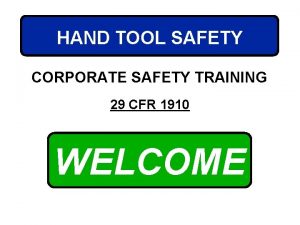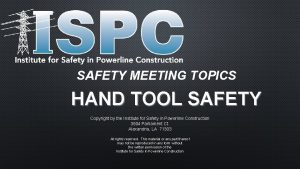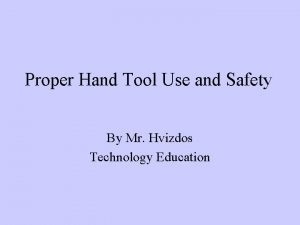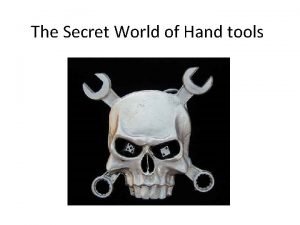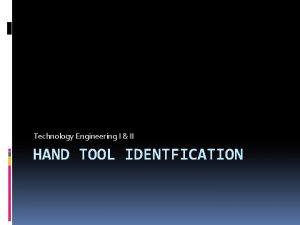Hand Power Tool Safety Introduction How to Use





















































- Slides: 53

Hand Power Tool Safety

Introduction How to Use this Presentation This presentation contains base material for use in an instructor-led training setting. You may modify this presentation to satisfy the specific training needs of your organization. On some slides, the display text is supplemented with additional material in the slide notes. This content is licensed for modification and use in a classroom setting. You may not redistribute this material in any form. DISCLAIMER This training material presents very important, pertinent information. It should not be assumed, however, that this program satisfies every legal requirement of every state. Some states require the training be developed and delivered by an individual with specific training and experience. This training is AWARENESS LEVEL and does not authorize any person to perform work or validate their level of competency; it must be supplemented with operation and processspecific assessments and training, as well as management oversight, to assure that all training is understood and followed. Your organization must do an evaluation of all exposures and applicable codes and regulations. In addition, establish proper controls, training, and protective measures to effectively control exposures and assure compliance. This program is neither a determination that the conditions and practices of your organization are safe, nor a warranty that reliance upon this program will prevent accidents and losses or satisfy local, state, or federal regulations.

Part 1 General Safety Employees who use hand power tools face many hazards. Most hazards, such as being struck by flying objects, inhaling harmful particles, and being pinched by moving parts can be avoided through proper work habits. In this chapter, we will learn the hazards associated with the use of hand power tools and what you can do to help prevent them. What you need to know: • Why hand power tool safety is important • Required employer responsibilities • Basic tool safety rules

General Safety Why Take Hand Power Tool Safety? Hazards of working with hand power tools: • Sharp or abrasive objects • Falling, flying, or splashing debris • Hazardous dusts, fumes, gases, mists, or vapors • Hazardous electrical connections, such as damaged or frayed cords or improper grounding

General Safety Responsibilities Employer responsibilities: • Assuring the safe condition of tools and equipment within the workplace • Training employees in the proper use and handling of tools and equipment Employee responsibilities: • Following established safe practices and procedures • Immediately communicating any identified hazards Employers are not allowed to issue or permit the use of unsafe hand tools.

General Safety Housekeeping Keep work and walking areas free of clutter to eliminate tripping hazards before accidents occur. • Store tools away from walkways, where they will not obstruct or trip employees. • Put away tools and equipment when not in use. • Dispose of construction debris in a timely manner. • Keep aisles, stairways, and doorways unobstructed.

General Safety Basic Tool Safety Rules • Only operate a tool if you are trained to do so. • Use the right tool for the job. • Operate according to the manufacturer’s specifications. • Wear the proper personal protective equipment (PPE). • Keep people that are not involved with the work away from the tools.

General Safety Inspection and Maintenance • Perform regular maintenance. ‒ Keep all tools clean. ‒ Keep sharp tools sharp. • Inspect the tool and perform tests daily and prior to use to verify that all safety measures are working properly. • Remove damaged tools from service and tag them, “Do Not Use. ”

Part 2 Hazards and Controls Improper use of tools can lead to serious injury or death. Nail guns alone cause 37, 000 emergency visits a year. Safe work habits and hazard controls, including machine guards and PPE, are essential for your safety. What you need to know: • Points of operation • Motion hazards • Machine guarding • Required PPE

Hazards and Controls Points of Operation The point of operation is the place where the work is actually performed on the materials. In the example to the right, the point of operation is where the saw cuts into the wood. This area presents a hazard for the employee using the saw. Points of operation need to be guarded. The guard on this power saw prevents the employee’s hand from reaching the point of operation.

Hazards and Controls Power Transmission Devices In addition to the point of operation, another hazard is the power transmission device. Power transmission devices, such as gears or belts, provide power. If these moving parts are exposed, machine guarding is necessary.

Hazards and Controls Motion Hazards Power tools present various motion hazards. Examples: • A rotating drill can grab loose material and pull it into the operating mechanism. This is known as a caught-in hazard and a rotation hazard. • Tools with two points rotating towards each other or tools with a rotating part converging with a stationary part create nip points. A nip point is another type of caught-in hazard, as it can trap body parts or clothes. • A saw blade creates a cutting hazard. Nip point In addition to guarding hazards, avoid loose clothing, jewelry, or hair when working around moving parts.

Hazards and Controls Machine Guarding Guards are now standard on most power tools. • Never remove a guard. • Never reach into an operating or guarded area of a tool when it is in use. • Routinely inspect installed guards for defects and check for proper function. • Guards must be designed by the manufacturer and installed by a qualified person. Circular saw guard

Hazards and Controls Machine Guard Examples Chop saws: Portable circular saws: Upper and lower guards must be installed on chop saws to prevent the operator from coming in contact with the rotating blade. When using portable circular saws, the guard must cover the full depth of the blade’s teeth. Do not tamper with these guards by pinning them open. Upper blade guard Lower blade guard

Hazards and Controls Machine Guard Examples Table saws must have the following guards: • A hood guard • A separator • An anti-kick-back device Hood guard

Hazards and Controls Required PPE Using PPE also reduces injuries in the workplace. PPE includes eye, face, and other body protection. • Use appropriate PPE for the tool and task. • Appropriate PPE may include gloves, safety goggles, ear protection, or a respirator. • Stay alert for nip point hazards when wearing gloves or PPE with loose or hanging straps or strings.

Hazards and Controls PPE must be selected based on the body part that is prone to injury and by the hazards that are present. PPE Examples Earplugs or earmuffs Dust mask or respirator Hard hat Safety glasses or goggles Vest or coveralls Safety gloves Safety boots

Part 3 Hand Tools Hand tools are powered manually. They include a wide variety, from screwdrivers to pliers. Mindful operation, inspection, and maintenance of your hand tools will prevent common injuries, including cuts, bruises, and lacerations. What you need to know: • Hand tool hazards • Utility knife safety • Proper housekeeping

Hand Tools Hand Tool Hazards Most hand tool hazards result from improper maintenance or use. • Never use hand tools for any purpose other than what they were designed for, e. g. , using a chisel as a screwdriver. • Never use tools that show signs of excessive wear. For example: ‒ Wrenches with sprung jaws ‒ Impact tools with mushroomed heads ‒ Tools with loose, cracked, or splintered handles ‒ Tools with taped handles, as the tape may conceal cracks

Hand Tools Hand Tool Hazards Sparks: Metal hand tools may produce sparks that can ignite flammable substances. When working around flammable hazards, use spark-resistant tools made of non-ferrous materials. Sharp edges: When using sharp tools, such as saw blades or knives: • Direct movement away from people and walkways. • Never use dull tools. They are more difficult to control and require more force, so they cause more injuries than sharp ones.

Hand Tools Utility Knives • Choose adjustable and closable knives. • Consider safety knives. Some of these knives are disposable, eliminating the hazard of changing blades. Other safety features include auto-retracting guards and recessed blades. • Use cut-resistant gloves. • Take great care when changing blades. Immediately replace dull blades, and discard the used blades in a rigid and sealed container.

Hand Tools Utility Knives Do not force the blade. Cutting tasks that require greater hand force have a greater risk of loss of control and serious personal injury. • Use knives only with appropriate materials, such as thin plastic tapes, wrappings, light cardboard, or paper products. • If the blade is tearing instead of cutting, it is likely too dull and should be replaced. • Repeat along your cutting line without applying greater pressure until the pieces separate if a single cut is not sufficient.

Part 4 Power Tools Improper use of power tools lead to approximately 400, 000 emergency room visits each year. Powered by electricity, air pressure, fuel, or even gunpowder, these tools require extreme caution to operate. What you need to know: • Electrical hazards • Best practices • Power tool types • Associated hazards

Power Tools General Precautions • Disconnect tools when not in use, before servicing and cleaning, and when changing accessories. • Follow your lockout/tagout program. • When possible, secure work with clamps or a vise, freeing both hands to operate the tool. • Do not hold the switch button while carrying a plugged-in tool.

Power Tools Electrical hazards: Power tools can present serious electrical hazards, including shocks, burns, and heart failure. It only takes a small amount of electric current to cause heart fibrillation or even death.

Power Tools Electrical cord precautions: • Assure that power cords are properly laid out or secured to prevent tripping hazards. • Do not use power cords to carry tools or to hoist or lower tools. • Do not disconnect tools by pulling on the cords or hoses. • Keep cords and hoses clear from hazards such as heat, oil, and sharp edges.

Power Tools Electrical Tools Grounding best practices: • Use double-insulated, three-wire cords that have a grounding pin. • Use tools with low-voltage isolation transformers. • An Assured Grounding Program is strongly advised. Double insulated markings Plug with a grounding pin

Power Tools Electrical Tools Other guidelines: • Only use electric tools within their manufacturer-specified design limits. • Keep work areas well lit and dry, unless the tool is approved for working in wet conditions. • When not in use, make sure that tools are stored in a dry place. • Use appropriate PPE to protect from flying or falling debris. This includes: ‒ Gloves, except where they would present a pull-in hazard ‒ Safety shoes.

Power Tools Electrical Tools Hand grinders and other portable grinding tools: • Install safety guards: Prevent the operator from coming in contact with the wheel surface and from flying debris if the wheel breaks. • Hold hand grinders during operation: Never place a hand grinder in a vise for operation.

Power Tools Electrical Tools Abrasive wheel guards: Abrasive wheels are hazardous because they can create flying debris while grinding, cutting, and polishing materials. Guards must: • Protect the user from foreign objects. • Maintain proper alignment with the wheel. • Only expose a minimal amount of the wheel.

Power Tools Electrical Tools Abrasive wheel measurements: • There should be ¼” of space between the top guard and the grinding wheel. • Work rests should be ⅛” or less from the wheel’s surface. This prevents work from getting jammed between the wheel and the rest. ¼” ⅛”

Power Tools Electrical Tools Abrasive wheel inspection: • Closely inspect abrasive wheels for damage prior to use. • Use the ring test to assure that the wheel is free from cracks or other defects: ‒ Gently tap the wheel with a light, non-metallic instrument. ‒ If the wheel sounds dead or cracked, do not use it, as it may not be structurally sound.

Power Tools Electrical Tools Abrasive wheel operation: • Stand to the side of the wheel as it reaches the proper speed. • Allow the wheel to reach the proper speed before starting on your grind or cut. • Do not grind with the side of the wheel. • Do not adjust the wheel or the rest while the wheel is rotating. • Install the wheel properly, not distorting the flange. Do not exceed the maximum spindle speed indicated on the wheel.

Power Tools Electrical Tools Hand drills: • Be aware of the drill’s voltage. If the torque is high, such as 24 -volt, you must hold the drill securely with both hands. • Hold the drill in a comfortable position. • For awkward positions, use a lower voltage drill, such as 18 -volt or less.

Power Tools Electrical Tools Drill presses: • Use appropriate PPE, including safety glasses or goggles and hearing protection. • Do not wear loose clothing or jewelry. • Secure work with a clamp or drill vise to keep it from being spun by the bit.

Power Tools Electrical Tools Hand-held power tools must include at least one of the following components. 1. Constant pressure switch: • Power is shut off when it is released. • Tools with this switch typically include chainsaws, circular saws, and hand-held drills. 2. On/off switch: • The tool will not start until the activation of the on/off switch. • It must be magnetic. • Tools with this switch typically include jigsaws, planers, and routers. Constant pressure switch

Power Tools Pneumatic tools are powered by compressed air. Examples include nail guns, jack hammers, and sanders. Dangers associated with pneumatic tools include being struck by moving parts and puncture wounds from flying nails and fasteners.

Power Tools Pneumatic tool safety: • Assure that proper safety devices are in place to prevent fasteners or attachments from ejecting when the muzzle is not in contact with your work surface. • Wear the proper PPE. • Keep hands well outside of operating areas. • Apply the same safety measures to air hoses that you would for electrical cords.

Power Tools Pneumatic Tools Fasteners for pneumatic tools: • Make sure that the tool is securely fastened to the air hose. • Use a positive locking device or short wire to keep the hose and tool attached. The hose and tool are secured by a wire.

Power Tools Pneumatic Tools Connections for pneumatic tools: Hose fittings are acceptable pneumatic tool connections, but hose clamps are not. Hose fittings Hose clamps

Power Tools Pneumatic Tools Air nozzles: If attaching a nozzle to a compressed air line, the air must be reduced to less than 30 p. s. i. The use of nozzles requires proper PPE (e. g. , eye protection). Do not use compressed air for cleaning. Clean your tools, work areas, or surfaces with a brush or vacuum instead.

Power Tools Powder-Actuated Tools Powder-actuated tools are powered by an explosive charge that drives a fastener into an object. If used without proper training, powderactuated tools can be deadly. Many people die of injuries from projectile nails. In one case, an employee was using a nail gun to anchor a plywood formwork. The nail killed an employee 20 feet away.

Power Tools Powder-Actuated Tools Operating guidelines: • Treat a powder-actuated tool like a loaded gun. • Only operate the tool if specially trained. • Only load the tool immediately before use. • Never point the tool at anyone. • Never leave a loaded tool unattended. • Never use in proximity to flammable or explosive materials or atmosphere. • Always survey and secure the surrounding areas. • Keep your hands clear from the barrel’s end at all times.

Power Tools Powder-Actuated Tools Safe use: Before firing, release the safety mechanism by placing the tool against the work surface and applying pressure of at least 5 pounds greater than the tool’s total weight. In the event of a misfire: • Hold the tool in its operating position for at least 30 seconds before attempting to fire it again. • If the tool misfires again, hold it in position for another 30 seconds, then carefully remove the charge per the manufacturer’s instructions. • The faulty charge must be placed in water immediately after removal. • If the tool is determined to be defective, it must be immediately tagged and removed from service until properly repaired.

Power Tools Powder-Actuated Tools Inspect tools daily and before each use to assure that: • The tool has the proper safety measures and attachments. • The safety measures are working. • The tool is clean. • Moving parts are operating freely. • The barrel is free from obstructions. Other guidelines: • Store the tool unloaded and in a locked box. • Everyone working in the area must wear the appropriate PPE, including ear protection. • Choose a powder level that performs the job without excessive force.

Power Tools Powder-Actuated Tools Know the characteristics of your work surface. • If a material is hollow or too easily penetrated, your pin or fastener may fire straight through. • If a material is too hard or brittle, it may chip or shatter upon impact or the fastener could ricochet.

Power Tools Liquid Fuel Tools Fuel-powered tools include concrete cutters and are typically gasoline-powered. They can emit fuel vapors and exhaust fumes that can ignite, explode, or pose threats to your health or the environment. Guidelines: • Prior to refueling, power down the engine and allow it to cool. • If using a fuel-powered tool in an enclosed area, assure that the area is properly ventilated or employees are provided with proper respirator devices and hearing protection. • Make sure fire extinguishers are readily available in the work area.

Part 5 Hydraulic Tools Hydraulic tools use pressurized fluid to transmit force. These tools are often used to lift, separate, or sever heavy materials. What you need to know: • Hydraulic tool precautions • How to use a jack safely

Hydraulic Tools Jacks A jack is a common type of hydraulic tool. Capacity: • All jacks must be marked with the manufacturer’s rated capacity and stopping point. • Never exceed the capacity or stopping point. Inspection and maintenance: Jacks should be lubricated and inspected on a regular basis.

Hydraulic Tools Jacks When installing a jack: • Assure that the jack’s base is on a firm, level surface. ‒ If the jack’s foundation is not firm, place a block under the jack base. • Center the jack under the load. • Place the jack’s head against a level surface. • To prevent the head from slipping, place a block between it and the load. • Make sure that lift force is applied evenly. • Stay out from under suspended loads.

Hydraulic Tools Jacks Cribbing: To support the load and provide a failsafe if the jack fails, loads must be cribbed incrementally during lifting. The railroad tie provides a firm base for the jack. The load is cribbed to prevent it from falling.

Summary Most hazards are caused by improper use or maintenance. • Only use tools after proper training. • Wear appropriate PPE. • Perform an inspection of the tool prior to use. • Verify that points of operation and motion hazards are guarded. • Always use safe handling and operating practices. • Keep body parts away from hazardous areas. • Store and maintain tools properly.

Congratulations! You have completed Hand Power Tool Safety.
 Osha power tool safety
Osha power tool safety Power tools must be fitted with guards and
Power tools must be fitted with guards and Hand tools ppt
Hand tools ppt Basic hand tools quiz
Basic hand tools quiz Hand safety tool
Hand safety tool Real power formula
Real power formula Ape hand
Ape hand Hour hand and minute hand
Hour hand and minute hand Mother father sister brother hand in hand with one another
Mother father sister brother hand in hand with one another Man type flow process chart
Man type flow process chart Joseph von eichendorff im abendrot
Joseph von eichendorff im abendrot Hand in hand module 1
Hand in hand module 1 Technology tools and equipment names
Technology tools and equipment names Right hand in the air
Right hand in the air Father mother sister brother hand in hand with one another
Father mother sister brother hand in hand with one another How to read analog clock
How to read analog clock Right hand in the air left hand in the air
Right hand in the air left hand in the air Ape hand vs hand of benediction
Ape hand vs hand of benediction What is the push and pull method
What is the push and pull method Ulnar nerve special test
Ulnar nerve special test Hand by hand
Hand by hand Handsoft pro
Handsoft pro Hand tool hazards
Hand tool hazards Hand tool id
Hand tool id Hand tool dexterity test
Hand tool dexterity test Dash ortho score
Dash ortho score Tst joint commission
Tst joint commission Carpentry tools and their classification
Carpentry tools and their classification Floral shears definition
Floral shears definition Manual hand forcible entry tool
Manual hand forcible entry tool Hand tool identification
Hand tool identification Hand tool hazards
Hand tool hazards Metalworking hand tool
Metalworking hand tool Potter's tool is data cleaning tool
Potter's tool is data cleaning tool Hand safety presentation 2018
Hand safety presentation 2018 Construction tool safety
Construction tool safety Aorn fire safety tool kit
Aorn fire safety tool kit Air tools definition
Air tools definition Compactor hazards
Compactor hazards Dhlt tracking
Dhlt tracking Basic tool safety
Basic tool safety Aorn fire risk assessment tool
Aorn fire risk assessment tool Safety attitudes questionnaire tool
Safety attitudes questionnaire tool Safety depth formula in ecdis
Safety depth formula in ecdis Safety care 2 person stability hold
Safety care 2 person stability hold Personal safety vs process safety
Personal safety vs process safety Safety assessment for ind safety reporting
Safety assessment for ind safety reporting Basic safety orientation
Basic safety orientation Construction site safety orientation
Construction site safety orientation Power tool cleaning
Power tool cleaning A power miter saw combines a miter box with a
A power miter saw combines a miter box with a What is a power plan
What is a power plan Brush tool in ms paint
Brush tool in ms paint Don't be a fool use the proper tool
Don't be a fool use the proper tool
